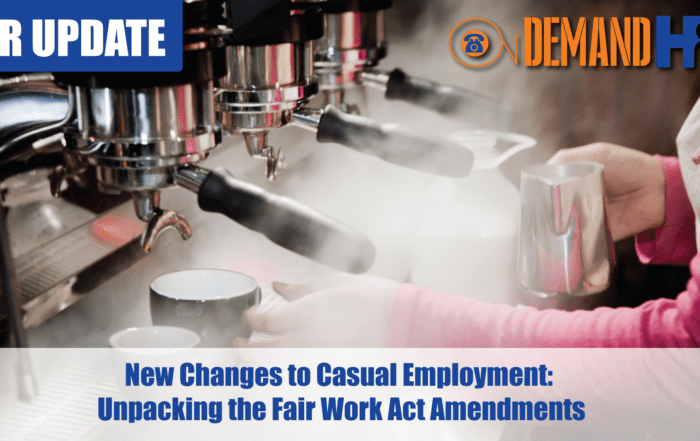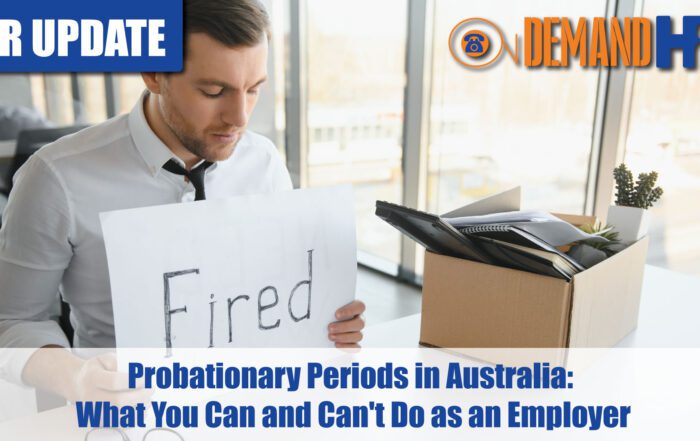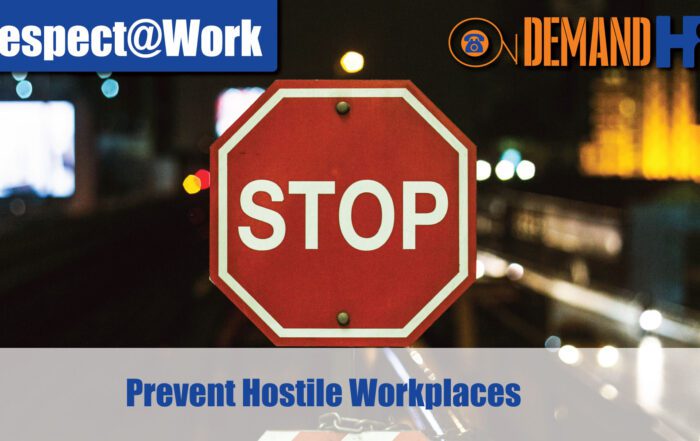JobKeeper 2.0 Legacy Businesses
In Episode 3 of HR Fridays Clint Indrele will be sharing the implications and considerations for those businesses who participated in JobKeeper 1.0 but will not be eligible for JobKeeper 2.0 coming into effect after 27 September.
Please see below for a full transcript of the video
Share the HR or workplace relations challenge facing your business and one of our experienced consultants will be in touch within 24 hours with a strategic action plan or discover the best strategy yourself by accessing out free online training library.
Transcript
Clint Indrele 0:15
Well, good morning ladies and gentlemen, welcome once again to HR Fridays here every Friday at 11:30. My name is Clint Indrele, Managing Director of On Demand HR. Once again, we’ve got another session for you in store today to talk through Workplace Relations topics. And every week we present a specific topic, please let us know of any topics of interest for future sessions. We’re always planning new and interesting ideas. The idea of this session every week is to provide a 10 to 15 minute bite sized content piece on something to do with Workplace Relations or employment or HR. Please let us know any comments you’ve got on today’s presentation. Please interact with us.
Clint Indrele 0:59
We are obviously every week here trying to provide advice, which is reality. Unfortunately, there are so many other providers out there providing advice or, or telling stories based on scare tactics based on things to just try and get you to sign up to their services. We’re trying to be honest, and we’re trying to be realistic about the sorts of prospects and the sorts of issues you’ve got to deal with in your day to day HR & Workplace Relations matters with employees. So trying to give you a perspective on a real understanding of risk. And for anyone who wants to know more about our services, visit www.ondemandhr.com.au.
Clint Indrele 1:40
Today’s presentation, I wanted to focus on some things relating to job keeper, but in particular businesses that are coming off job keeper in the next couple of weeks. So what that will be known as is legacy businesses. So these are businesses that still have the ability to ultimately use some of the powers that are available under Section 789 of the Fair Work Act, to essentially change employment arrangements, and so on and so forth. So, look, we’ll get into the content in just a moment.
Clint Indrele 2:10
So basically, to start off with this whole understanding of what a legacy business is, as most of you would know, job keeper requires a 30% decline in your turnover. Okay, so ultimately, what the ATO is going to be assessing at the end of September is whether or not your revenue declined 30% compared to a similar period last year, okay. For businesses that don’t quite make the qualification of the 30% reduction, there is still an ability to use the provisions of the Fair Work Act to make changes to your employment arrangements. So and what the legacy provisions are designed designed to do is that if you’ve still got less than 30, but more than 10% decline in your business, compared to the same period last year, you can effectively issue certain job keeper enabled directions. So we’ll get into particularly what those are in a moment.
Clint Indrele 3:05
And first of all, a job keeper enabled direction, the most common direction that is used by businesses is directing an employee to work less hours, okay. So ultimately, we’re in the normal course of events. If you wish to go to an employee and wish to change their hours, you would normally need to do it by agreement. But these special provisions of Section 789 allow businesses just in this job keeper, kind of and COVID environment to tell employees or direct employees to work less hours, whether they agree to it or not. And these legacy provisions will continue to allow employers to have those particular rights beyond their job keeper, coming to an end, provided that they’ve still got a 10% or more decline in their business.
Clint Indrele 3:53
So how do you justify this 10% decline in business? Well, for businesses have over 15 employees, you will require a turnover certificate from your accountant or from your bookkeeper ultimately. So that is essentially proof or some sort of documentary evidence that you have actually got a decline. And as a result of that, you can use the powers under the Fair Work Act. And if you have less than 15 employees, the provisions are such that you can do this by a statutory declaration. So you can essentially complete a statutory declaration to say that your turnover is down by 10% or more.
Clint Indrele 4:29
So the most common thing that these directions will be used for is to direct full time employees to work less hours. So either that’s four days a week or three days a week. Please note that with these new legacy provisions, you must direct an employee to work no less than 60% of their pre COVID hours and the pre COVID hours are ultimately the average hours or the hours that they were working at in February 2020, which was immediately prior to the first kind of series of job keeper provisions if you like.
Clint Indrele 5:01
The minimum daily engagement is at least two hours. So that’s another condition that needs to be met. And there is no longer the ability to direct employees to take annual leave, however, you do have the ability to, of course, still communicate with your employees and discuss annual leave arrangements. What’s going to be interesting is whether or not you can issue an annual leave direction prior to the end of September, which carries over into October, my view is that you can do that. So for those businesses who are thinking about reducing leave balances and won’t have job keeper beyond the end of September, it might be a good idea to start thinking about, well, should I be directing my employees to take leave at the end of September, continuing into October before my rights to obviously those things, essentially a phased out.
Clint Indrele 5:47
So in terms of the future of these job keeper enabled directions to reduce working hours, there are some more what is onerous consultative provisions, which require seven days consultation and the opportunity for employees to nominate a support person at during that process. So, again, for employees who have directed employees to work less hours, and we’ll come off job keeper at the end of September, this is something you’re going to need to deal with one way or another, whether it’s bringing them back to full time hours, because business has improved or whether or not it’s directing them to continue on reduced hours or less hours or a little bit more hours, post September given the business circumstances. So that is essentially the core of some of these key issues around job Kiba legacy businesses.
Clint Indrele 6:39
We will move along to the next piece of information that I was wanting to present. And basically look, there is going to be some challenges for business coming up in the next few weeks. And there’s certainly going to be challenge on borderline businesses to complete their monthly or quarterly BAS’s quickly enough to make their job keeper fortnight obligations. So obviously, this is for the businesses that will be continuing to have job keeper or might be right on the borderline. And I’m not quite sure about whether they are in or out. And unfortunately, the difficulty with all of these provisions around job keeper and around the directions in respect to job keeper, but is it always requires the business to predict what is going to happen. And whilst that might be fine, if you’re well under 30%, or well over 30%, the ones that are in that, you know, 25 to 35 bracket who might not necessarily know where they’re at until the end of the mouth. It is it is quite challenging for them. So we recognize and understand that is a, that is a key issue.
Clint Indrele 7:38
The second thing is that we also have a situation where, you know, certainly some businesses are finding new efficiencies with the way they’ve operated their businesses, and then might not have the requirement for people to come back to 60% of their pre COVID hours. Now look, obviously that’s going to bring about potentially redundancy type discussions. And again, there is a whole bunch of other considerations around redundancy, which require again, consultation prior to carrying out a redundancy, it requires you to pay redundancy pay if you have over 15 employees, it requires you to provide notice, sometimes it will require you to pay pro rata pay long service leave or pro rata long service leave. So there’s a lot of considerations around if I am looking to restructure or make someone redundant, how much is the cost of that? And second of all, how long is that going to take me to undertake and carry out that process in a manner which is fair and reasonable and is likely to have a low risk should the matter go to the Fair Work Commission.
Clint Indrele 8:41
So again, in terms of consultation around both redundancy and in terms of job keeper, and I think that, you know, the Fair Work Commission will assess both of these things on whether or not you know, consultation has occurred. So if you’re issuing directions, if you’re making people redundant, it’s very important to do it properly, no matter no matter how imperative or how critical it may be to reduce costs in your business. Because the last thing you want is after paying out redundancy pay, notice long service leave annual leave, and all those other things. The last thing you want is an employee to go to the Fair Work Commission and have a you know, second bite at the cherry or or a second whack at the second whack at the situation in terms of you know, monetary compensation or monetary outcomes.
Clint Indrele 9:31
I think the other thing at the end of this some job key period is going to be very interesting. It’s going to provide the first indication as to how some zombie businesses may fare as they are weaned off job keeper. Obviously, for some time people are having you know, 50% or more of their wages being subsidized by job keeper and now they’re going through a situation where potentially zero percent of their wages are being subsidized by job keeper. So that is a pretty significant shift. So for businesses that were you know, even if there are only 10% down. That’s going to still be a very testing time, because you’re going to have, you know, back to full wages back to full accruals. Of course, and also a situation where, you know, work may not be at the levels that it needs to be.
Clint Indrele 10:15
So certainly some difficult decisions ahead for businesses. But again, if you are coming off job keeper, and you still need to be reducing your employee hours beyond this particular date, look, and feel free to get in touch with us to talk through, you know, any issues that you might have around those arrangements, what you’re considering in terms of the reduction of working hours, it’s a great time to also be negotiating ongoing new arrangements, if you can see that there’s not going to be a full time role for someone going forward. Well, an alternative to redundancy could be just simply saying, look, I have a part time role for you going forward, let’s discuss how that might work. And putting in place those permanent arrangements.
Clint Indrele 10:58
We need to remember we’re still in a time where businesses, you know, there’s still a number of businesses that are finding it tough, the economy hasn’t recovered to its to the to full extent. And, you know, people just taking redundancies and going off into the abyss might not be actually what they want, they might actually prefer to remain with their current employer, even if it’s on a reduced basis or part time basis, rather than, you know, potentially be out of work for up to another, you know, three, six months, who knows a year depending upon which industries that they might be specialized in. So, again, don’t underestimate the ability to offer your employees alternative arrangements or new negotiated arrangements as an alternative to redundancy. And look, in any case, a business has an obligation to consider alternatives in a redundancy process as part of its obligations under Section 389 of the Fair Work Act. So again, or considering alternatives is what you should be doing from a compliance point of view anyway, why not discuss those things in a meaningful manner with your employees and try to come to some views on how that may look with him in the future?
Clint Indrele 12:08
Anyway, that’s all I really have for today on job keeper legacy businesses. Look, I’d like to thank you all viewers for your time today. I look if you’ve got any questions or comments, feel free to leave them in the comments box happy to reach out to you following the session. Or you’re most welcome to contact On Demand HR as well. Our website is there on the post below. It’s www.ondemandhr.com.au once again, Clint Indrele Managing Director of On Demand HR for our regular HR Fridays segment. We’ll have another one next week, Friday at 1130. Every week, please put a reminder in your calendar and we look forward to having your company once again. Thanks very much.






